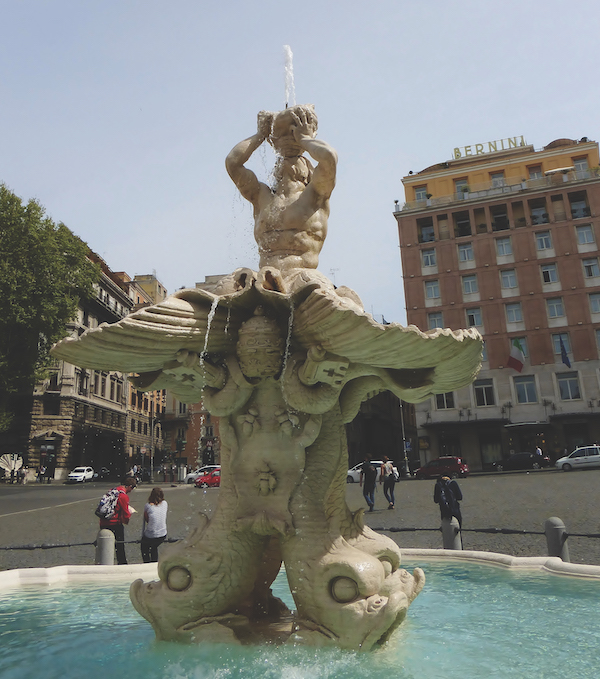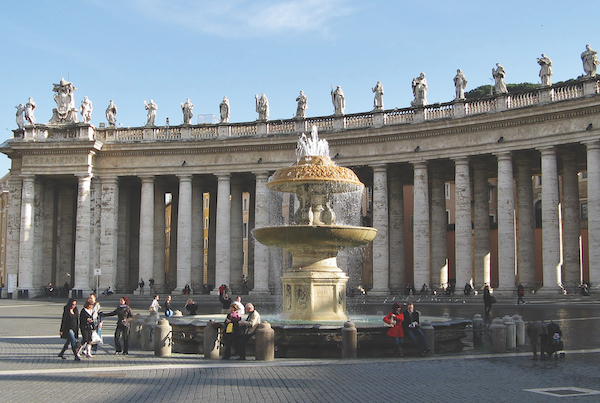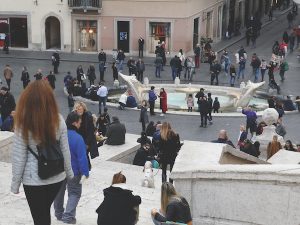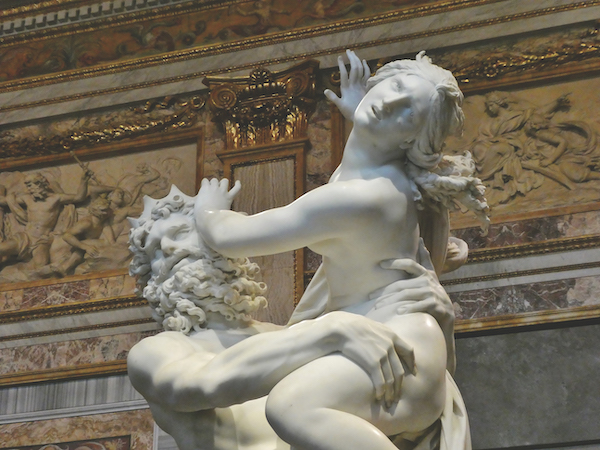The sculptor and architect created many of Rome’s most iconic sights – you can hardly take a selfie without him bombing you. Words by Joe Gartman, photos by Patricia Gartman

Let us imagine that you are standing in Piazza Barberini, in Rome, gazing at the famous Triton fountain. Triton, the giant son of Poseidon and Amphitrite, kneels upon on a huge, open bivalve shell. Four dolphins, partly submerged in a travertine pool, hold the shell balanced on their upright tails, and from this unlikely perch Triton blows a powerful plume of water from a conch shell. (In Greek myth, Triton’s duty is to announce his father’s presence.) But is it really Poseidon who’s being announced? The square is dominated by the Triton; and at the bus stop where Via Veneto meets the piazza is the famous “Fountain of the Bees”. A wall of the magnificent Palazzo Barberini borders the square. All three were designed by one man, and giant letters on a hotel rooftop beyond the Triton make their own announcement: BERNINI.
Bernini. It’s impossible to escape Gian Lorenzo Bernini for long in Rome. You can hardly throw a selfie-stick in Rome without hitting something he designed, or constructed, or carved. Some people, of course, don’t particularly like baroque art or architecture, and Bernini is definitely the godfather of Roman Baroque; so, for those people who want to avoid Bernini burnout, I offer the following list of places and things to avoid in Rome:

The Vatican
Pope Alexander VII said: “If one were to remove from St Peter’s everything that has been made by Cavalier Bernini, that temple would be stripped bare.” An overstatement, perhaps, but inside the church you can’t ignore the enormous Baldacchino sheltering the tomb of St Peter. It’s a gargantuan bronze version of the traditional canopy carried above the Pope’s head on holy days. Nor can you miss the golden setting for the precious wooden “Chair of St Peter”, or the numerous statues and tombs Bernini created. Besides, you can’t get into the church without going through St Peter’s Square, which Bernini created – all of it – except for the obelisk and one of the two fountains. He also designed the Colonnade, 248 giant ionic columns that form the great, embracing arms encircling the square, with 140 statues on top of them.
Castel Sant’Angelo
This formidable mausoleum was built by the Emperor Hadrian for himself and his family, so it’s certain that Bernini didn’t design it. Later it became a fortress, and, since there is a secret passageway from the Vatican to the castle, Pope Clement VII found it a good place to ride out the Sack of Rome by Charles V’s troops in 1527. On top, the statue of Archangel Michael sheathing his sword celebrates the end of the plague in 590 AD. And visiting Puccini fans will remember Floria Tosca’s tragic leap. Unfortunately, the bridge crossing the Tiber, the Ponte Sant’Angelo, is lined with ten statues of angels designed by Bernini, so you’d better give the whole thing a miss.

The Spanish Steps
There’s a fountain that looks like a little sinking boat in Piazza di Spagna, right below the steps. It’s called La Barcaccia. You can’t miss it – literally. Most people find it charming. It was sculpted by Gian Lorenzo’s father, Pietro Bernini. Gian Lorenzo may have helped, so better not take a chance.
The Pantheon
This spectacular building is the most complete structure from antiquity left in Rome. Inside, light streams through the oculus of an awe-inspiring, coffered dome. Happily, the fountain in the Piazza della Rotonda, just outside, was designed by Giacomo della Porta, not Bernini; but, if you stray behind the Pantheon, in front of the Church of Santa Maria Sopra Minerva you’ll encounter an obelisk sitting on a marble elephant. Bernini carved the elephant. Be warned.
Piazza del Popolo
The four captivating lion fountains surrounding the central Egyptian obelisk are by Giuseppe Valadier, but unfortunately the inner face of the ancient Porta del Popolo, through which the Via Flaminia enters Rome, was remodeled by Bernini in 1655 to welcome Queen Christina of Sweden. And, in the piazza’s Church of Santa Maria del Popolo, the statues of Daniel and Habakkuk are also Bernini’s work. Too bad that you won’t be able to see the two Caravaggio canvases.
Sant’Andrea al Quirinale
Bernini designed and built this church. It’s as baroque as it gets. ‘Nuff said.
Piazza Navona
Do I need to mention the Four Rivers Fountain? Or the figure of the Moor?
Santa Maria della Vittoria
In the Cornaro Chapel, Bernini carved, in white marble, the Ecstasy of Saint Teresa, based on the autobiography of Teresa of Ávila, in which she describes the “surpassing sweetness” of the pain she feels as an angel pierces her heart with a golden arrow. The sculpture balances dangerously between the spiritual and the sensual. There are many other dangerous Bernini works in Rome, of course. Pope Urban VIII told Bernini, “You are made for Rome, and Rome for you,” and backed his opinion with lots of commissions. But the most perilous place of all is…

Galleria Borghese
Here, Bernini’s youthful, exuberant works in white marble for Cardinal Scipio Borghese threaten to ensnare the most committed Berniniphobe: Daphne, fleeing the amorous Apollo, is frozen in flight as her hair and fingers become impossibly translucent, delicate laurel leaves, and tree-bark envelopes her torso; David grimaces in fierce determination as he coils his body and readies his sling; Hades carries Persephone down to his grim kingdom, and the god’s fingers dimple the struggling maiden’s thigh so convincingly that you might believe her body has become flesh.
So, if you enter, you may become like the rest of us, dazzled by a conjuror in marble who, like Emperor Augustus, transformed Rome.
For more articles on Rome, check out our archive
